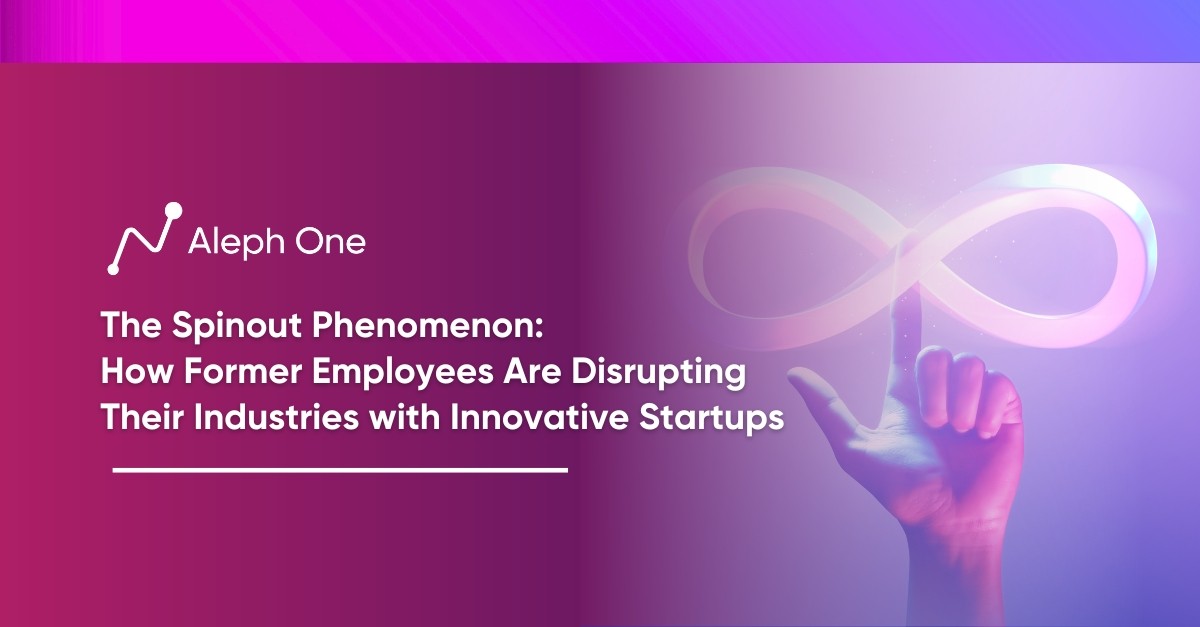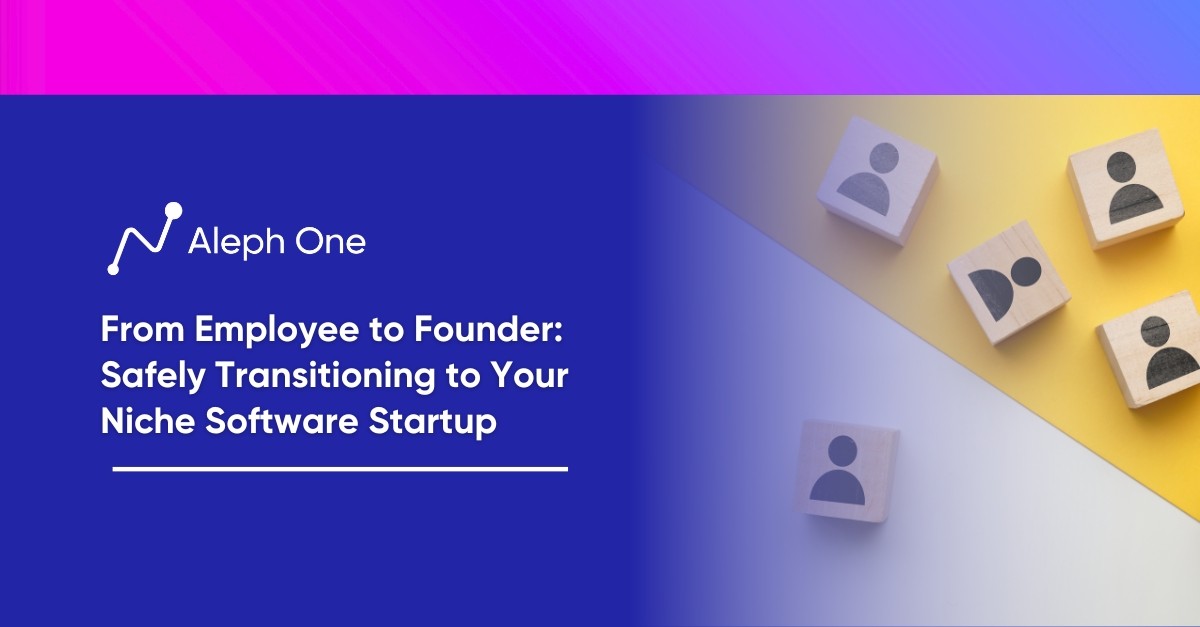Let’s work together to build something amazing. Share your project details and our team will reply to figure out the next steps to your success.

A silent revolution is underway in industries from technology to transportation to healthcare. While large incumbents focus on incremental improvements to existing business models, their former employees are busy engineering the next wave of radical innovation. These corporate spinouts—startups born from the minds of intrapreneurs trapped inside a big business—are poised to disrupt the status quo in ways their former employers never imagined.

The Invisible Force Driving Disruption
A silent revolution is underway in industries from technology to transportation to healthcare. While large incumbents focus on incremental improvements to existing business models, their former employees are busy engineering the next wave of radical innovation. These corporate spinouts—startups born from the minds of intrapreneurs trapped inside a big business—are poised to disrupt the status quo in ways their former employers never imagined.
Large Corporations Hindering Innovation
According to Harvard Business School, 73% of disruptive new business ideas come from within large companies. They rarely see the light of day. Rigid processes, office politics, and focus on short-term gains mean that transformative concepts often must be addressed or watered down beyond recognition. The frustration of seeing their ideas squandered or suffocated slowly builds until the only option is to break free.
How Intrapreneurs Are Born
For these restless intrapreneurs, spinning out an independent startup is a chance to give their vision new life. No longer constrained by a big company’s inertia and risk aversion, they are free to develop ideas that challenge sacred assumptions and push the boundaries of the industry. The results can be radical new products, services, or technologies that upend the existing order.
How are Spinouts Different?
While large companies struggle to see beyond the status quo, spinouts enjoy a unique advantage: an intimate knowledge of an industry gained from years inside, combined with an entrepreneurial drive to shake things up. They understand the complex dynamics of an enterprise, know where the most significant opportunities for disruption lie, and can see new possibilities their corporate counterparts miss. Armed with this insight, spinouts are poised to out-innovate established players.
The era of the corporate spinout has only just begun. As more radical thinkers break free from big companies to pursue transformative ideas, spinouts marrying insider knowledge with an outsider’s drive to disrupt are poised to shape the future of innovation. Large incumbents that find a way to leverage this phenomenon will thrive while others are caught off guard. The invisible force driving disruption is about to become impossible to ignore.
Why Good Ideas Get Stifled
Large, established companies are not set up to foster radical new ideas. They are built to optimize existing business models, not reinvent them. Everything from their processes and incentive structures to their corporate cultures is designed around sustaining what already works. This makes them ill-suited to develop ideas that could cannibalize existing products or upend the status quo.
Ideas Ignored Due to Management or Bureaucracy
This reality can be stifling for employees inside these companies who have visions of new products, services, or even entirely new business models. Their most innovative concepts often need to be addressed or watered down beyond recognition as they work through layers of management and committees. What might have begun as a transformative idea can end up as little more than a minor tweak to the existing way of doing things.
Obstacles and Pushback
Frustration mounts for these intrapreneurs trapped inside a big business. They face constant obstacles and pushback, watching helplessly as their ideas are either shelved or stripped of anything radical. For these thinkers, breaking free from the constraints of corporate life eventually becomes the only option to pursue their unfettered vision.
Large Companies Lack Frameworks to Support New Ideas
Large companies also often lack mechanisms to evaluate and support new ideas that could significantly disrupt existing operations. Anything threatening the current business model is considered too risky, no matter the potential long-term benefits. Short-term thinking and a focus on optimizing quarterly results mean resources are rarely devoted to cultivating entirely new concepts that could take years to develop and yield an uncertain payoff.
For radical innovators, the choice becomes clear: remain shackled to a system that does not value your ideas and watch them wither, or take a leap of faith to spin out an independent startup. One path leads to frustration and regret, while the other offers the chance to build something transformative. The startup path is the only one that makes sense for true visionaries.
From Intrapreneurs to Entrepreneurs
In recent years, there has been an explosion of corporate spinouts across industries. These spinouts leverage industry experience gained from years inside significant companies but are freed from the constraints that held back their ideas.
Examples of Spinout Startups
Some of the most famous spinouts have gone on to become significant disruptors. PayPal came from employees of a security software firm. Slack was born out of a failed internal collaboration tool at a gaming company. 23andMe was founded by the wife of Google co-founder Sergey Brin to market a health screening product Google passed on.
These companies and many others like them are proving that time inside a large corporation can be an asset, not a liability, for entrepreneurs. The key is tapping into knowledge and networks gained from years of experience unencumbered by bureaucracy and short-term thinking.
For example, PayPal’s founders knew security software inside and out but wanted to apply it to digital payments, an idea their original company dismissed. Similarly, Slack’s founder built on the collaborative concepts he developed internally but was free to create a product true to his vision. 23andMe’s CEO was intimately familiar with the power of large datasets and analytics thanks to her time at Google but was able to explore health applications Google was uninterested in.
Deep Industry Insight is Vital for Spinout Success
The spinout enjoyed an unparalleled advantage in each case: deep industry insight and an outsider’s freedom to disrupt. They knew the rules of their industries so that they could break them. This powerful combination of insider knowledge and outsider drive has allowed spinouts to out-innovate established companies that once employed their founders. The era of the corporate spinout has only just begun, but they are already demonstrating a new model of innovation that should make ample businesses notice.
The Best of Both Worlds
Spinouts enjoy a unique advantage that makes them a force to be reckoned with: an intimate knowledge of an industry gained from years of experience inside a company, combined with an entrepreneurial drive to shake things up. They understand the complex dynamics of an industry in a way outsiders never could, but they are no longer constrained by the institutional forces that stifle change.
How Spinouts Are Different From Regular Startups
With this potent combination of insight and freedom, spinouts are poised to out-innovate established players. They know the game’s rules intimately and can strategically break them. They can spot opportunities that others miss and move quickly to seize them. They also know the most significant weaknesses in existing companies and business models.
Paypal, 23andMe, and Slacks Competitive Edge
PayPal founder Max Levchin leveraged his experience working for financial services companies to start a digital payments business the banks never envisioned. 23andMe’s Anne Wojcicki drew on her knowledge of the biotech industry to launch a direct-to-consumer genetic testing service long before big pharma would dare. And Slack’s Stewart Butterfield tapped his background building gaming companies to create a new form of workplace collaboration that traditional enterprise software vendors had failed to imagine.
In each case, the spinout founder possessed an insider’s grasp of the industry’s potential and limitations. They could see the gaps that needed filling and exactly how to fill them. But they were no longer held back by the short-term priorities, rigid mindsets, and risk aversion that dominate most large organizations. Free from these constraints, they were able to develop solutions quickly, get them to market fast, and ultimately disrupt the status quo.
Leveraging Relationships and Expertise
Spinouts can leverage relationships and expertise from their time inside a company, even as they break free from constraints. They may maintain connections with former colleagues, continue to contract work, or secure startup funding from their ex-employers. This allows them to build on an established company’s resources and knowledge base while still forging their own path.
In these ways, spinouts enjoy the best of both worlds: tapping industry experience gained from years inside a company but with the freedom and drive of an entrepreneurial venture. It is a combination that gives them the insight, ambition, and agility to reshape industries. The era of the spinout has only just begun.
A New Model for Innovation?
Some forward-thinking companies are now actively encouraging spinouts, providing funding and support while still reaping the benefits. Rather than stifling innovative concepts, these companies spin them into independent startups, retaining equity stakes or exclusive licensing deals. This allows big companies to place strategic bets on new ideas while giving them room to grow unencumbered.
Google Ventures
Google is a prime example of a company that has spun in and spun out new ventures. Google Ventures, the company’s venture capital arm, has funded over 300 startups, many of which were founded by ex-Googlers. Google still benefits through licensing deals and acquisitions, such as with Nest Labs, a smart home device maker based by former Google employees. Google’s open innovation program also allows employees to spend 20% of their time on side projects, some of which have become successful spinouts like AdSense.
Amazon Web Services, Microsoft Azure, and IBM Alpha Zone
A few other tech giants are following suit. Amazon Web Services and Microsoft Azure offer resources to help startups get off the ground, hoping to build an ecosystem of companies that grow into acquisition targets. IBM’s Alpha Zone program provides funding and support for employees developing disruptive ideas that IBM isn’t well-positioned to pursue. If successful, IBM can bring the new ventures back into the fold.
While promising, this model also presents challenges. There is a risk of losing control over valuable ideas and intellectual property. There is also uncertainty about whether spinouts will succeed or if big companies will be able to reap the benefits. However, the more considerable risk must be addressed in today’s innovation economy. With a carefully managed program that provides the right level of support and incentive for both the spinouts and parent companies, this new model could represent the future of corporate innovation.
The Future is Spun Out
Corporate spinouts are just getting started. As more intrapreneurs break free from big companies to pursue radical ideas. Some of today’s most transformative companies began as spinouts, including PayPal, Slack, and 23andMe. But they are just the first wave. In the coming decades, spinouts will shape the future of industries from transportation to healthcare to education. They will do to established players what startups did to Blockbuster and Kodak.
Big Companies Need to Adapt
Big companies have two options: leverage the spinout phenomenon or be left behind. The smart ones are choosing the former by running “spin-in” programs. They provide funding and support for spinouts, which can become partners, suppliers, or acquisitions. It’s a way for companies to benefit from radical ideas they would otherwise stifle. Spin-ins allow them to place multiple bets in fast-changing markets.
Spinouts – The Driving Force for Innovation
In the coming decades, spinouts will emerge from the shadows to become a driving force of innovation. They have the knowledge and networks to reshape industries from within, combined with the drive and agility of startups. By embracing this phenomenon, big companies can participate in the disruption. But those that fail to adapt will be disrupted.
The era of the spinout has only just begun. These startups born within the belly of the beast are poised to shape our future. Incumbents, be warned.
Get the latest news and updates from Aleph One in your inbox.



